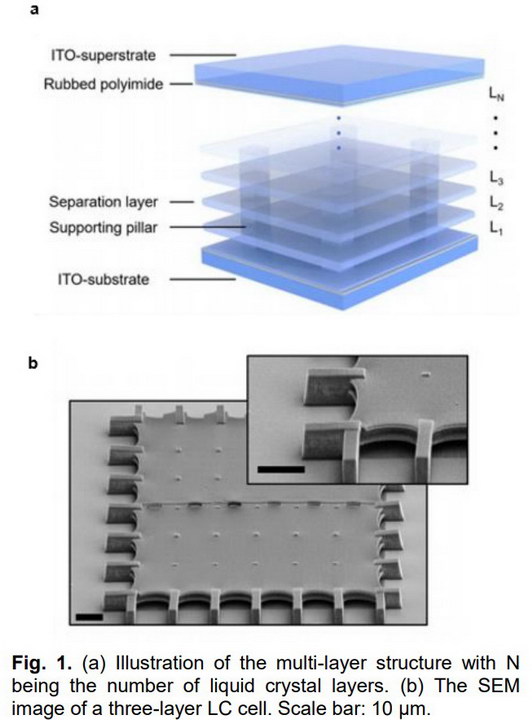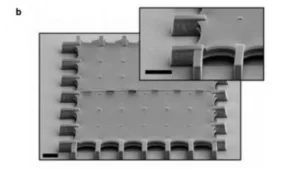VR and AR systems need high-speed displays with short latency in order to provide a good AR or VR experience. This is mostly a problem for LC microdisplays because OLEDs are fundamentally high-speed and OLED microdisplays are typically limited by their backplane design. Backplane designs for OLEDs are dominated by pixel pitch and resolution issues, as discussed in another article in this special report.
Paper 44-1 was titled “Motion-blur-free LCD for High Resolution Virtual Reality Displays” and came from Fangwang Gou and his colleagues at the University of Central Florida and AU Optronics Corp. They discuss a new transmissive LC mode they call VA⊕FFS. This is a high speed mode, although it is not high enough for a color-sequential system. Instead, the goal was to reduce motion picture response time (MPRT) and perceived motion blur. The worst-case gray-to-gray LC response time is about 4mS. One unusual thing about this LC mode is it is designed to work with left and right circular polarizers while most other LC modes use linear polarizers.
 (Source: SID 2018 paper 44-2)
(Source: SID 2018 paper 44-2)
Another (relatively) high speed IPS effect came from LG Display and was discussed in paper 44-2 titled “Fast Response Time Advanced High Performance In-plane Switching (AH-IPS) Mode for High Resolution Application” written by Soo In Jo and his colleagues. Like the UCF/AUO VA⊕FFS LC system, the new version of the AH-IPS LC mode had about a 4mS worst case gray-to-gray response time.
Another paper (51-4) titled “Ultra-Fast Moving-picture Response-time LCD for Virtual Reality Application” from Chang-Hung Li and his colleagues at AU Optronics and iboson Technology Corporation also focused on MPRT. They made sample panels with two different transmissive LCD designs and 1008 PPI resolution. Design 1 and Design 1 had average MPRTs of 2.2mS and 1.5mS respectively. Since the authors gave no indication of what designs 1 and 2 were, it is hard to evaluate their technology.
 LED Duty Cycle and MPRT at various frame rates for the Himax CF-LCoS panel. (Source: SID paper 51-5)
LED Duty Cycle and MPRT at various frame rates for the Himax CF-LCoS panel. (Source: SID paper 51-5)
A third paper (51-5) titled “Fast Motion Picture Response Color Filter LCOS for Wearable Applications” from Yuet-Wing Li and his colleagues at Himax Display focused on improving MPRT. This microdisplay used the double mirror structure for the CF-LCoS that was introduced by Himax at SID in 2014 (Paper 18.2). Response time was optimized through the use of analog drive and a full frame buffer. Note that a full frame buffer may improve MRPT but Himax doesn’t mention that it is also likely to increase system latency. This may not matter much since the Himax CF-LCoS panel is more suited for AR applications than VR applications where latency is a critical problem. While the panel may be driven at frame rates up to 450Hz, this would result in very low output since the white LED would have a very low duty cycle. The authors cited data showing that when the MPRT was less than 1.5mS, motion blur was not noticeable. The CF-LCoS can achieve this MPRT at a drive frequency of 270Hz, which will allow a LED duty cycle of about 50%.
 Structure of the UCF multi-layer structure. While the structures appear opaque in this SEM image, they are made of an optically transparent polymer. (Source: SID 2018 paper 44-3)
Structure of the UCF multi-layer structure. While the structures appear opaque in this SEM image, they are made of an optically transparent polymer. (Source: SID 2018 paper 44-3)
Paper 44-3, “Large Area Multi-Layer Liquid Crystal Phase Modulators Enabled by Two-Photon Polymerization” from Daniel Franklin and his colleagues at the University of Central Florida can be thought of as “blue sky” research not likely to produce commercially viable, high-speed LCD microdisplays in the foreseeable future. The speed of a LC is determined in part by the thickness of the LC layer and transmissive LC layers are rather thick. The technology presented in this paper is to divide the LC layer into two or three different layers, reducing the response time by a factor of 4X and 7X respectively. This is done by building a polymer trellis structure to separate the LC layers inside the cell. Unfortunately, the structures are made by a scanned laser system that can produce the layers at a rate of 0.01 Inch² (6.5mm²) per hour. While the researchers see how to expand the system to make 0.5” (12.7mm) square microdisplays, much more work is needed before the technique can be used in a product.
A second paper (44-4) from the University of Central Florida was titled “New Liquid Crystals Enabling High-Frame-Rate LCoS for Augmented Reality Displays” was written by Yuge Huang and his colleagues. When used in LCoS systems, these three new LC mixtures enable 240-Hz spatial light modulators and 1080-Hz amplitude modulators for augmented reality displays. Experimentally, at 40°C it achieves a 2.08mS average gray-to-gray response time.
Paper 51-1 titled “Optimal Fast-Response LCD for High-Definition Virtual Reality Head Mounted Display” by Toshiharu Matsushima and his colleagues from Japan Display Inc. discussed a high-speed LCD panel that used the Short-range Lurch Control In-Plane Switching (SLC-IPS) LC mode introduced at SID in 2015 (Paper 43.2). By optimizing the IPS electrode design, the authors said they improved the LC response time from 4.5 ms to 2.2 ms while maintaining high cell transmittance, which made the design suitable for high-definition VR-HMD.
Paper 51-2 titled “Development of In-Plane Super-Fast Response (IP-SFR) LCD for VR-HMD” from Takashi Katayama and his colleagues at Sharp discussed another high-speed IPS design. They built a demonstration unit with a panel size of 2.89 inches and a resolution of 706 ppi. The only change from the previous design of this panel was an optimization of the IPS electrode shapes – the same LC mixture, transistor design and drive scheme were used. This optimization improved the gray-to-gray response time from the previous design of slowest: 13.0mS, average: 7.9mS to values of slowest: 6.8mS, average: 4.8mS. This new design is said to now be in mass production. An additional advantage of the optimized design, according to the authors, was that it would allow reduction in pixel size while maintaining system throughput. –Matthew Brennesholtz

